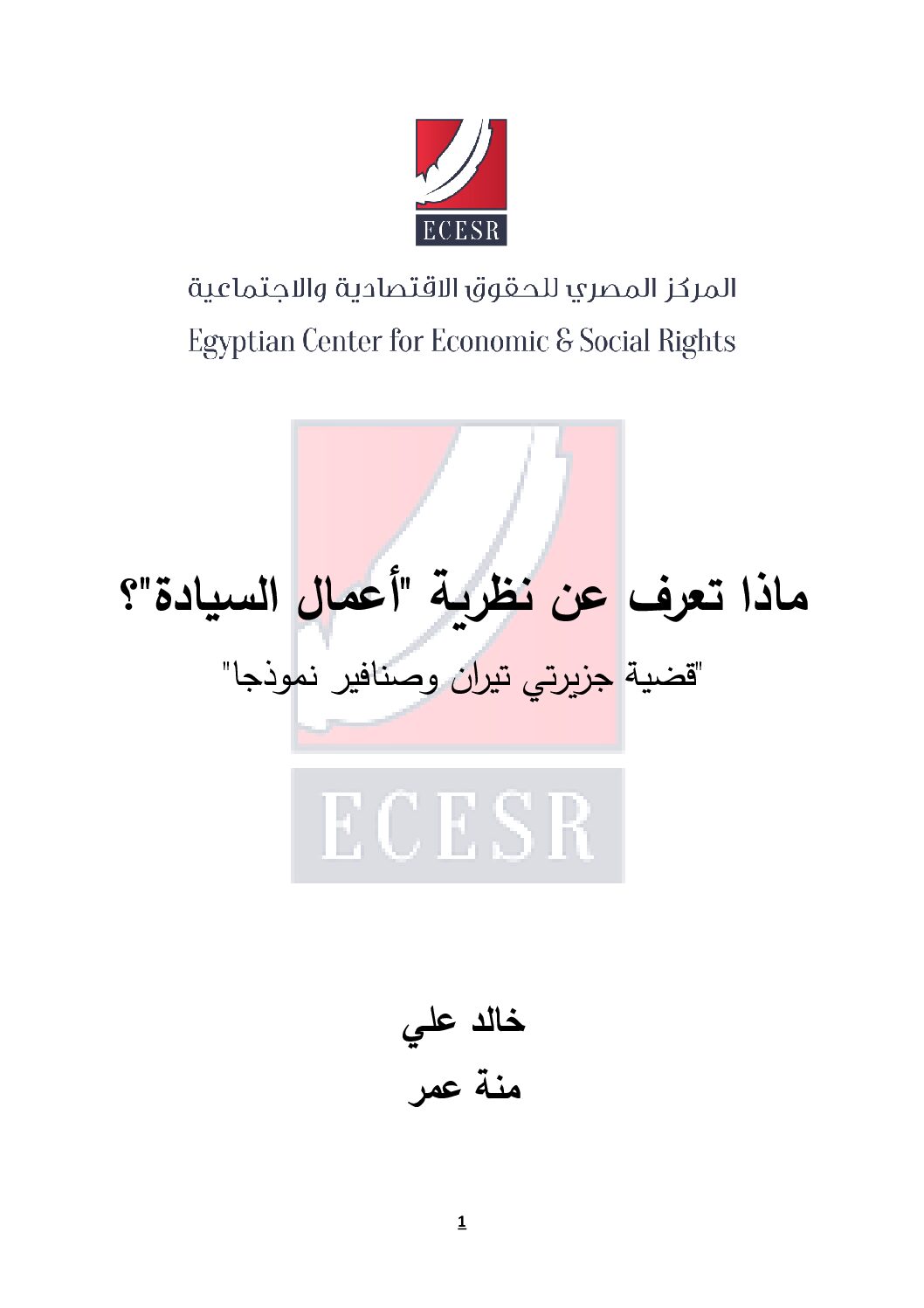An urgent proceeding filed by the Egyptian Center for Economic and Social Rights (ECESR) to stop demolishing the cemeteries of Historic Cairo, that include the cemeteries of Orabi, Umm Kalthum and Imam Warsh

The Egyptian Center filed an urgent proceeding before the Administrative Court in the State Council against the Prime Minister, the Minister of Tourism and Antiquities, the Minister of Housing, Utilities and Urban Communities, the Head of the Supreme Council of Antiquities, Cairo Governor, and the Head of the Urban Development Fund, demanding the halt of the negative decision by abstaining from providing necessary protection to cemeteries and archaeological buildings with distinguished architectural heritage located in Historic Cairo Cemeteries region, together with establishing a sacred place to these antiquities, with the consequences of that, most notably stopping the removal and demolition of all these cemeteries and buildings.
The Center stated in the lawsuit, as an attorney of a group of professors and consultants for the preservation of urban heritage and those interested in antiquities and heritage, including dr. Jalila Gamal El Qady, dr. Monica Hanna, eng. Tareq El Merry, Mrs. Sally Suleiman, dr. Dalia Hussein, that the lawsuit was filed due to the removal operations that are carried out in the region of the Historic Cairo Cemeteries in Khalifa neighborhood in South Cairo, known as Al Imam Al Shafaie Cemeteries, and Al Sayyida Nafisa Cemeteries dated back to the 7th century AD, which is currently located in the North, South and East of Salah Salem Road. In the late 19th century, these areas were allocated to bury State senior officials and notables, and were established on the same models of the old cemeteries hundreds years ago of the late prominent iconic persons in thought, culture, politics, religion, and art, as well as the members of the Royal family. In addition, these cemeteries contain the remains of a large group of great people in the Egyptian national struggle, thought and history.
Recently, news, photos, appeals for aid and demands have spread regarding assaults on the region, and the removal of a number of its archaeological buildings randomly while implementing constructions in the region that aren’t appropriate to its nature and buildings, together with facing severe dangers, such as erasing part of Egypt’s history, heritage building and desecrating the remains of a significant number of its great people in all fields, as several cemeteries were removed, including the cemetery of Abdel Hamid Basha Saddiq who was the Speaker of the Egyptian Parliament from 1902 to 1909 during the reign of Khedive Abbas Helmy II, the cemetery of Abdullah Afandi Zohdi who was one of the most well-known calligraphers in Egypt’s history and he was the writer of manuscripts on the Prophet’s Mosque, Sabil Umm Abbas, Al-Rifa’i Mosque and others. In addition to the Cemetery of Hassan Afandi Al Laithi who was the painter of of the Holy Kaaba Cover, together with Eshq Berian who was a liberated handmaids of Khedive Ismail. Moreover, the news circulating about the removal of Imam Warsh Cemetery who was the owner of the second most common readings of the Holy Qur’an in the Islamic World.
The region contains a large number of cemeteries built in a distinguished architectural style, including the cemeteries of the Prince of Poets Ahmed Bey Shawky, Umm Kalthum, the graveyard of queen Farida, Mahmoud Samy El Baroudy, Sabil and cemetery of Jala Al Din Al Suyuti, Prince Fouad, Asmahan, Farid Al Atrash, the Dome and Mosque of Mahmoud Basha El Falaky, Fatima Al Zahraa Mosque, and other cemeteries of historical and Egyptian figures, together with mosques, domes and sabils.
Within a short period of time, the demolition and removal of parts of the Historic Cairo Cemeteries region have started to implement plans dedicated to establishing and expanding a number of roads and axes which resulted in demolishing or the collapse of a number of the buildings and establishments with peculiar architectural style in an absence of any governmental statements or explanations regarding the details of the plan and without any actual supervision from the competent authorities in the country to protect the aforementioned buildings or the area legally identified for protection, such as the inspectors, the Ministry of Antiquities experts, or the National Organization for Urban Harmony, except the presence of the demolition and removal teams and workers
In its edition No.74 issued on March 29, 2023, the Egyptian Gazette published the decision of the Minister of Housing, Utilities and Urban Communities No.233 of 2023, which stipulates in its 2nd Article: “Adding 86 cemeteries in Khalifa and Moqattam neighborhoods, starting with No.1 (the Cemetery of the Prince of Poets, Ahmed Bey Shawki) and ending with No.86 (Manna’a Cemetery)
At the same time, the guards of a number of cemeteries mentioned in the decision were notified with the plans to remove them, including the grave yard of Mohamed Ratib Basha Al Serdar, the Cemetery of the Syrian Al Azm family, Lieutenant General Ismail Salim Basha, Rashwan Basha, Abdullah Al Prince Yusuf Kamal, Nasha’at Del Qaden who was the wife of Khedive Ismail, Ali Basha Fahmy, Mahmoud Samy Al Baroudi, Ahmed Shafiq Basha, Ibrahim Al Helbawy, and Mohamed Mahmoud Basha. It’s noteworthy that the above cemeteries which were registered according to the aforementioned decision, and that signs were painted on the outer walls of some of these cemeteries.
ECESR asserted that the aforementioned decision to only specify 86 cemeteries in this region is considered a waste to the value of the other buildings and antiquities with peculiar architectural style, including but not limited to: The cemeteries of Yehia Basha Ibrahim, Mohamed Basha Al Shafai, the graveyard of Mah Doran, Ali Basha Ibrahim, Saifu Allah Basha Yousry, Abdel Khaleq Basha Tharwat, Said Basha Zulfaqar, Bahey El Din Basha Barakat, Ismail Basha Asem, Leader Ahmed Oraby, Othman Basha Ghalib, Amin Basha Al Manastralli, and other cemeteries including miniatures, inscriptions and archaeological designs linked to different historical eras.
And between a verbal notice of the removal of a number of cemeteries and graveyards registered as buildings and establishments with peculiar architectural style, and the ignorance of registering or including others, together with the continuity of the removal and demolishing operations and expanding the roads through using heavy machinery under the control of workers untrained to work in archaeological regions, in addition to the absence of guarding or supervision to ensure avoiding any depreciations to these buildings or demolishing some of them by mistake. Moreover, that represents a disdain to the remains of several prominent figures and symbols who contributed in building the history of Egypt through years. The appellants filed several complaints, reports and appeals to stop these practices for the public interest and to save a significant part of Egypt’s history, the latest of which was sending telegraphs to the Prime Minister, the Minister of Tourism and Antiquities, the Minister of Housing, Utilities and Urban Communities, Cairo Governor, the Head of the Urban Harmony, and the Head of Urban Development Fund, “in their capacities”.
Since the appellants didn’t receive any response or explanation or letter from the appellees, in addition to not taking any necessary measures to protect these buildings, thus they decided to file their lawsuits based on the articles of the Egyptian Constitution that obligate the state to preserve the Egyptian cultural identity with its various civilizational branches. Moreover, the articles of the constitution oblige the protection of antiquities and the preservation of its regions, together with maintaining them and retrieving what was stolen, in addition to organizing excavations and supervising them, while prohibiting to be gifted or exchanged. Moreover, the Articles of the Constitution describe assaults against these buildings or trafficking in their contents as a crime that has no statute of limitations.
Moreover, Article No.50 of the Egyptian Constitution stipulates that: “Egypt’s material and moral civilizational and cultural heritage of all types and form all of the Paranoiac, Coptic, Islamic, and modern periods are a national and human heritage that the state commits to protect and maintain. The same applies to the modern architectural, literary and artistic cultural stock. Any attack thereon is a crime punishable by law. The state gives special attention to maintain the components of cultural diversity”.
According to the provisions of law No.117 of 1983 on Antiquities Protection and its amendments “any real state or chattel is considered an antiquity whenever it meets the following conditions: (1) to be the product of Egyptian Civilization or the successive civilizations or art or science or literature or religion that took place on the Egyptian lands since the pre-historic ages and during the successive historic ages till before 100 years. Or to be of archaeological or artistic value or of historical importance as regarded a manifestation of the Egyptian Civilization or other civilizations that established on Egypt’s land, and the remains of human races and their contemporary beings are considered as antiquities that are registered according to law.
Article No.2 of Law No.144 of 2006 regulating the demolition of non-dilapidated buildings and establishments and the preservation of architectural heritage stated that “it shall be prohibited to authorize demolishing or adding to the buildings and establishments with peculiar architectural style that are correlated to the country’s national history, or a historic figure, or represent a historical epoch, or considered a tourist site, without derogation from the legally payable compensation”. Other than the aforementioned, it isn’t permissible to demolish or attempt to demolish the building except with a permit issued according to the provisions of law.
According to the law regulating the removal of buildings and non-perishable structures, and the preservation of architectural heritage, the grounds for the prohibition of the license of removal or construction to the buildings which have a distinguished architectural style related to the national history or a historical character or have been built in a historical era provide two pillars: The first: That the building has a distinguished architectural style. And the second: That the building is linked to a national history or a historical character or era. Thus, it isn’t sufficient to register a building in the architectural heritage records for buildings prohibited to be demolished as they were built in a distinguished architectural style, but rather it must be linked to one of the aforementioned criteria provided by the legislator.
It’s noteworthy that the Supreme Administrative Court stated in its ruling issued in Appeal No.1932 of the Supreme Judicial Year No.56 in the session held in 05/07/2010, that there are buildings considered tourist places whether they have a distinguished architectural style or otherwise. This was confirmed in the aforementioned joint committee report through the example of Umm Kalthum Villa that was considered a tourist place despite not being built in a distinguished architectural style. As in this case, the legislator wanted to preserve the architectural heritage of these buildings and protect Egypt’s cultural character as it is considered a vital part of the Egyptian entity.
ECESR indicated that a large number of cemeteries, shrines and Sabils located in these regions are considered unique pieces of art due to its architectural styles or its date of construction or inscriptions or stones. Furthermore, these regions turned into a tourist site for thousands of Egyptians, Arabs and foreigners who are interested in architectural heritage, the Egyptian History to see unique pieces of art. Thus, the Center considered that the removal and demolition operations are a disdain to a part of Egypt’s history and represent danger to a significant area of its heritage and historical area. Moreover, the removal violates the Constitution, law, and the duties of preserving the Egyptian heritage and identity that were formed over thousands of years.
In its lawsuit, the Center stressed that the Appellees abstained from taking necessary procedures to protect the aforementioned buildings and cemeteries, together with abstaining from identifying an area to these places. Moreover, the appellees abstained from completing the counting of buildings and facilities linked to the national history and related to Egyptian and foreign figures who had a clear impact on the movement of society, including Imams, writers, poets, political leaders, artists, prominent officials and members of the Royal Family, etc. Thus, all the above is considered a clear legal violation to law which harms the public interest, the history of Egypt, and the right of the coming generations to knowledge.

